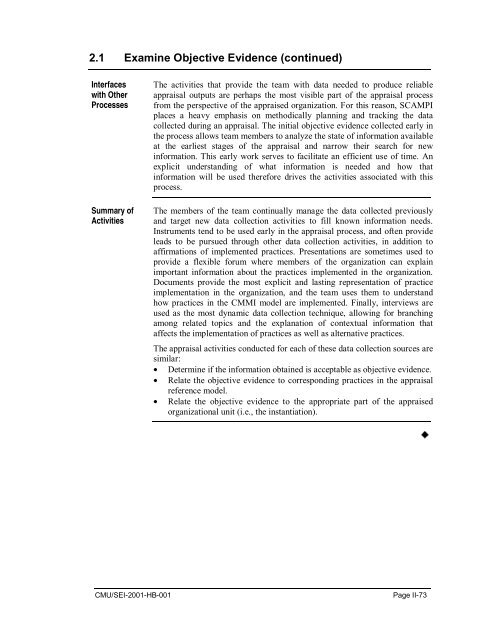Standard CMMI Appraisal Method for Process Improvement (SCAMPI)
Standard CMMI Appraisal Method for Process Improvement (SCAMPI)
Standard CMMI Appraisal Method for Process Improvement (SCAMPI)
You also want an ePaper? Increase the reach of your titles
YUMPU automatically turns print PDFs into web optimized ePapers that Google loves.
2.1 Examine Objective Evidence (continued)<br />
Interfaces<br />
with Other<br />
<strong>Process</strong>es<br />
Summary of<br />
Activities<br />
The activities that provide the team with data needed to produce reliable<br />
appraisal outputs are perhaps the most visible part of the appraisal process<br />
from the perspective of the appraised organization. For this reason, <strong>SCAMPI</strong><br />
places a heavy emphasis on methodically planning and tracking the data<br />
collected during an appraisal. The initial objective evidence collected early in<br />
the process allows team members to analyze the state of in<strong>for</strong>mation available<br />
at the earliest stages of the appraisal and narrow their search <strong>for</strong> new<br />
in<strong>for</strong>mation. This early work serves to facilitate an efficient use of time. An<br />
explicit understanding of what in<strong>for</strong>mation is needed and how that<br />
in<strong>for</strong>mation will be used there<strong>for</strong>e drives the activities associated with this<br />
process.<br />
The members of the team continually manage the data collected previously<br />
and target new data collection activities to fill known in<strong>for</strong>mation needs.<br />
Instruments tend to be used early in the appraisal process, and often provide<br />
leads to be pursued through other data collection activities, in addition to<br />
affirmations of implemented practices. Presentations are sometimes used to<br />
provide a flexible <strong>for</strong>um where members of the organization can explain<br />
important in<strong>for</strong>mation about the practices implemented in the organization.<br />
Documents provide the most explicit and lasting representation of practice<br />
implementation in the organization, and the team uses them to understand<br />
how practices in the <strong>CMMI</strong> model are implemented. Finally, interviews are<br />
used as the most dynamic data collection technique, allowing <strong>for</strong> branching<br />
among related topics and the explanation of contextual in<strong>for</strong>mation that<br />
affects the implementation of practices as well as alternative practices.<br />
The appraisal activities conducted <strong>for</strong> each of these data collection sources are<br />
similar:<br />
• Determine if the in<strong>for</strong>mation obtained is acceptable as objective evidence.<br />
• Relate the objective evidence to corresponding practices in the appraisal<br />
reference model.<br />
• Relate the objective evidence to the appropriate part of the appraised<br />
organizational unit (i.e., the instantiation).<br />
<br />
CMU/SEI-2001-HB-001<br />
Page II-73
















